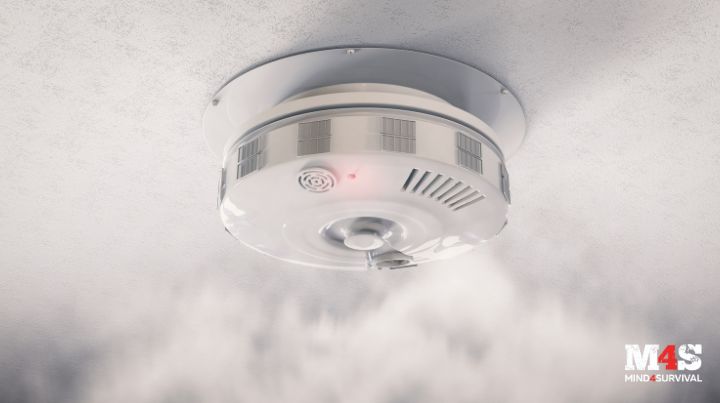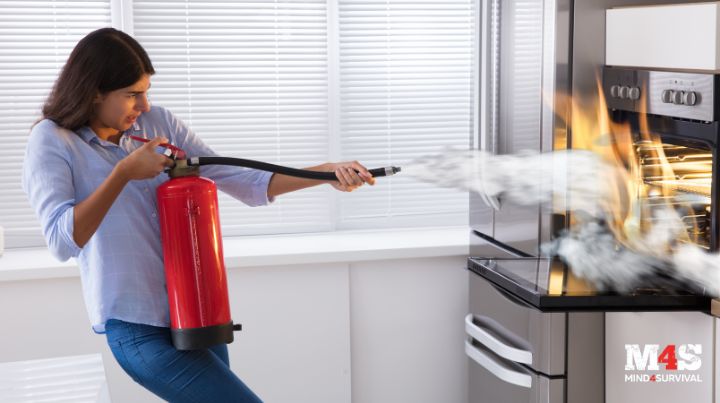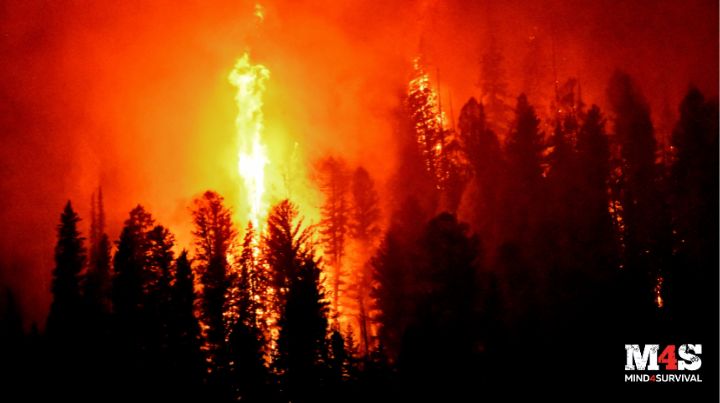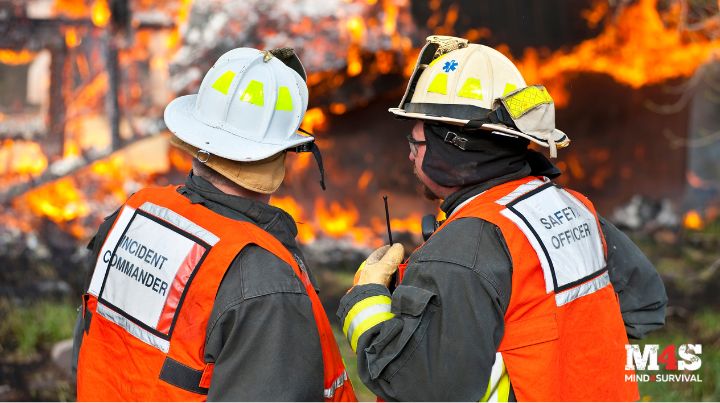Podcast: Play in new window | Download
Fire safety is an essential aspect of home safety that often goes overlooked. Yet, understanding how to prevent and respond to fires in and near your home can be the difference between life and death. As we all know, fires can start unexpectedly, spread quickly, and cause significant damage. While that’s terrible during the best times, it can be devastating when resources and support are limited or non-existent during a disaster. To help with that, this article will pull from my years of firefighting experience to dig into crucial strategies and measures you can take to enhance fire safety in your home.
Quick Look at What You’ll Learn
Kitchen Safety
The kitchen is a hotspot for fire hazards—pun intended. Never leave cooking food unattended. Grease fires, often caused by overheated oils, are particularly dangerous as they can flare up and consume the kitchen with little notice. Never use water on a grease fire, as the water can carry the burning oil and spread the flames. To extinguish a grease fire, smother it with a lid or use a fire extinguisher, which should always be ready near your stove. Also, keep flammable items like towels, wooden utensils, and pot holders away from the stove. Be mindful of using a towel as a pot holder when working around stoves, as a dangling end can quickly catch fire.
Heating Equipment
Heating equipment, such as space heaters and fireplaces, are a significant fire risk. Keep space heaters at least three feet away from anything that can burn, and never leave them unattended. Ensure your fireplace has a screen to prevent sparks from escaping and setting your roof or nearby vegetation on fire. Also, have your chimney cleaned regularly to avoid a buildup of creosote, which can cause a chimney fire that can spread to the rest of your home.
Electrical Safety
Electrical fires can result from faulty wiring, overloaded outlets, or malfunctioning appliances. Regularly inspect electrical cords for damage, and avoid running them under rugs where they can fray and start the rug smoldering. Use surge protectors and never overload outlets with too many appliances and devices. If you notice flickering lights or frequently tripped circuit breakers, consult a qualified electrician to inspect your wiring. If you notice that happening and there’s no electrician available, reduce the number of devices plugged into that circuit or shut the circuit breaker off until you can inspect and repair your electrical system.
Smoking Materials
Smoking materials, such as cigarettes, cigars, and pipes, are another common cause of home fires. Always smoke outside, and use deep, sturdy ashtrays. Ensure that all smoking materials are fully extinguished before disposing of them. Never smoke in bed because many homes have burned to the ground after their owners fell to sleep with a lit cigarette in their mouths.
Candle Safety
During good times, candles add ambiance to a room. Likewise, when the power may be out, candles can be an essential light source. Regardless of why candles you light candles, they always add a significant fire hazard to your home. To help minimize the danger of candles, always place them in sturdy holders and keep them away from flammable items and spots where they can be knocked over. Be sure to extinguish candles before leaving a room or going to bed. Whenever possible, consider using flameless candles, which provide the same effect without the fire risk.

Fire Detection
Early fire detection with smoke detectors can save lives and minimize damage. Install smoke alarms on every level of your home, inside bedrooms, and outside sleeping areas. Test them monthly to ensure they are working correctly, and replace the batteries at least once a year. For added safety, consider installing interconnected smoke alarms, which will all sound if one is triggered.
Fire Extinguishers
Another crucial safety measure is having fire extinguishers readily available. Place them in accessible locations near potential fire hazards, such as the kitchen and garage. I keep one near my bedroom door so I can go straight to the fire source if a fire starts at night while I’m sleeping. Likewise, that fire extinguisher can help me should I need to extinguish any flames on my way out of the house. I also have an extra fire extinguisher to keep nearby if I’m doing anything that possibly causes a fire.

The next step in using fire extinguishers is to learn how to use them effectively. The PASS technique—Pull the pin, Aim low, Squeeze the handle, and Sweep the nozzle—can help you remember the steps. Your local fire department may offer fire extinguisher classes, so check there for great training opportunities. Also, regularly check the pressure gauge and have extinguishers serviced as needed.
Fire Escape Plan
A well-thought-out fire escape plan can save lives. Every household should have a fire escape plan that includes at least two ways out of every room. Choose a meeting place outside where everyone can gather after escaping.
Practice your escape plan at least twice a year to ensure everyone in your home knows how to get out safely. Be sure to make your home fire drills fun and not scary. Trying to scare people will make some mentally check out of the drill and set them up for failure should a fire ever happen. You can make them fun by turning them into a game and having a reward like pizza, ice cream, or something your family likes to do together.
Educating Children
Teaching children about fire safety is vital. Ensure they know how to respond if they hear a smoke alarm and understand the importance of not hiding during a fire. Teach them how to use the back of their hand to check doors for heat and to “stop, drop, and roll” if their clothes catch fire. Role-playing different scenarios can help them remember what to do in an emergency. Remember, don’t scare them–empower them!
Pet Safety
Pets are part of the family, and their safety is also essential. Include pets in your fire escape plan. Ensure they have a collar and leash that are easily accessible in case you need to evacuate quickly. Remember to get your pets chipped so they can be returned if they run out without being on a leash. Practice evacuating with your pets so they are familiar with the process.

Preventing Wildfires
Additional precautions are necessary for those living in areas prone to wildfires. Maintain a defensible space around your home by clearing away flammable vegetation. As a Southern California firefighter, we told people to clear the brush 200 feet (60 meters) from their homes. Use fire-resistant materials for roofing and siding and install spark arresters on chimneys. Have an emergency kit ready and know your evacuation routes and procedures.
Seasonal Fire Hazards
Different seasons bring different fire hazards. During the winter, heating equipment and holiday decorations increase fire risks. Keep live Christmas trees well-watered, and inspect holiday lights for frayed wires. In the summer, outdoor grilling and fireworks can pose hazards. Always supervise grills and never use fireworks near dry grass or other flammable materials.
Home Fire Sprinkler Systems
Installing a home fire sprinkler system can significantly reduce the risk of severe fire damage. These systems activate when they detect high heat, controlling or extinguishing fires before they can spread. While not a substitute for smoke alarms, they provide additional protection and can be particularly beneficial in areas with limited access to fire services. In the end, while cleaning up from a sprinkler’s downpour can be a pain, trying to recover from a burned-out home is much worse.

Fireproofing Your Home
Consider fireproofing measures to increase your safety. Fire-resistant building materials, like brick, stone, and metal, can slow the spread of flames. Fire retardant sprays and treatments for fabrics and wood surfaces can also help. Seal gaps around windows and doors to prevent drafts that can feed a fire.
Insurance Considerations
In an age of increasing wildfires and insurance cancellations, ensure your home insurance policy covers fire damage. Review your policy regularly to understand what is included and what has changed and make any necessary adjustments. Document your possessions with photos and keep important documents in a fireproof, safe, or offsite location.
The Bottom Line on Home Fire Safety and Prevention
Fire safety is an ongoing necessity that requires personal responsibility, vigilance, and preparedness. By understanding the risks and taking proactive measures, you can protect your home and loved ones from the devastating effects of a fire.
What are your thoughts and experiences with home fire safety and prevention? Have you had a home fire? Tell us about it in the comments below.
Additional Resources:
Stay safe,

Read the full article here


